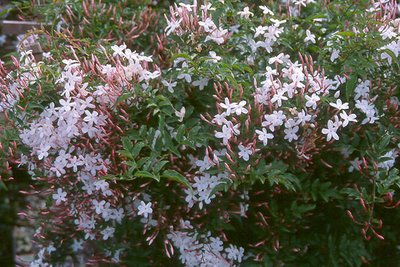Types of Jasmine
Picture of Jasminum nudiflorum
Shrubby jasmines
The winter jasmine (Jasminum nudiflorum) is the star of this group, forming a loose open deciduous shrub that will scramble its way through a border by rooting at the tips of each arching stem rather like a bramble. Left to its own devices it will eventually reach 3x3m (10x10ft). However, it is easy to control, and because it roots so readily it is very easy to propagate. Winter jasmine is a remarkable plant in several ways. For start it is hardy almost anywhere in the country and it can trained up wires against a wall or fence where its lolloping growth will spill haphazardly out in all directions. It also has remarkably green stems that are particularly noticeable and welcome in winter once the leaves have fallen. Then when nearly all else has shut-up shop for the winter freeze, it defies the cold by lightening up the gloomy garden with a dazzling display of bright yellow flowers. Winter jasmine needs no companions but if you want to create a bit of extra colour on a winter's day plant with witch hazel for their complementary spidery flowers of sulphur yellow and honeyed orange. For a bolder contrast, plant with a skimmia, their bright red berries standing out alongside the green and yellow of the jasmine. S. reevsiana is an excellent variety which has an abundance of dark pillarbox-red fruit each winter. Another shrubby jasmine worth seeking out is J. humile 'Revolution'. This evergreen bushy shrub grows to about 1.8x1.5m (6x5ft) and bears deep yellow flowers with a delicate fragrance throughout the summer months. Although not as hardy as the winter jasmine it is still robust enough for most areas.
Hardy cli mbers
mbers
Although the shrubby winter jasmine can be trained against a wall or fence, only the true climbing jasmines can cling on to their supports unaided.
The summer jasmine (J. officinale - picture on the left) is particularly valued for its delicious, free-ranging perfume that can transform the atmosphere of a garden on a summer's evening. It is a vigorous twining climber so is ideal for growing over a pergola or arch to create a fragrant arbour or trained along a fence next to the patio to permeate the evening air with its delightful perfume. The attractive star-shaped white blooms are produced in succession from June until early autumn and stand out against the backdrop of attractive dark green divided foliage. The plant will cover an area 12x6m (40x20ft) if given a sheltered spot where it is not exposed to winter cold. If you are looking for something a little different, consider the variegated summer jasmine J. officinale 'Argenteovariegatum' which has green leaves that are attractively edged with white.
Jasminum beesianum
It is smaller than the species, reaching 4x4m (15x15ft) so more suited to a confined space. It is just as floriferous and the blooms are highly scented. The new variety 'Fiona Sunrise' creates a completely different effect in the garden because its leaves are suffused with gold making the whole plant stand out.
Reaching 6x4m (20x15ft), it is particularly useful for drawing the eye and forming a focal point. Like the summer jasmine it is deliciously scented when in flower throughout the summer months. Other hardy climbing jasmines to look out for are J. beesianum which bears clusters of rose-red, slightly scented flowers in early summer followed by black berries. Reaching just 4x3m (15x10ft) it can be grown to cover a single fence panel or one side of an arch by a sunny doorway where its delicate scent can be appreciated. If you want more flower power, opt for J. x stephanense which bears masses of pink blooms in June and July. This one is more vigorous, reaching 4x1.5m (15x5ft).
Jasminum stephanense
Indoor jasmines
There are few plants that can transform a dreary winter room like Jasminum polyanthum. Even just a couple of flowers will suffuse through the house filling the air with uplifting perfume. Usually trained along hoops in a small pot as a table decoration, it can also be given more space in a larger container with a supporting framework of trellis. In a conservatory, it can be grown in a raised bed and trained on wires along walls or even overhead where it can reach 6x6m (20x20ft) if allowed. However, it responds well to regular trimming and so can be kept to size and flowering well whatever the available space.
Picture of Jasminum polyanthum









0 Comments:
Post a Comment
<< Home